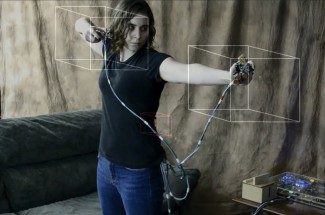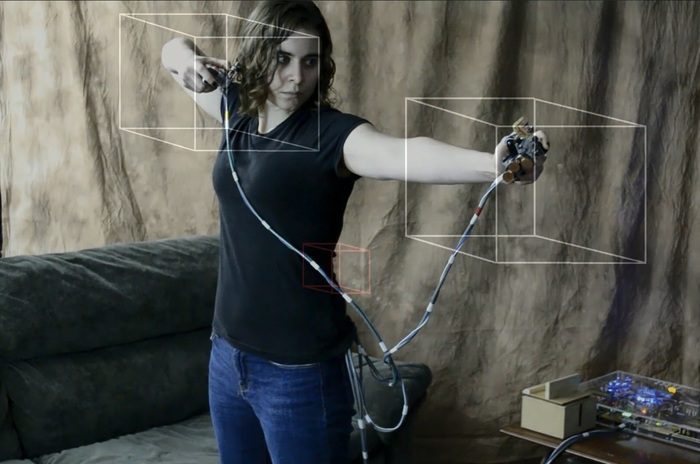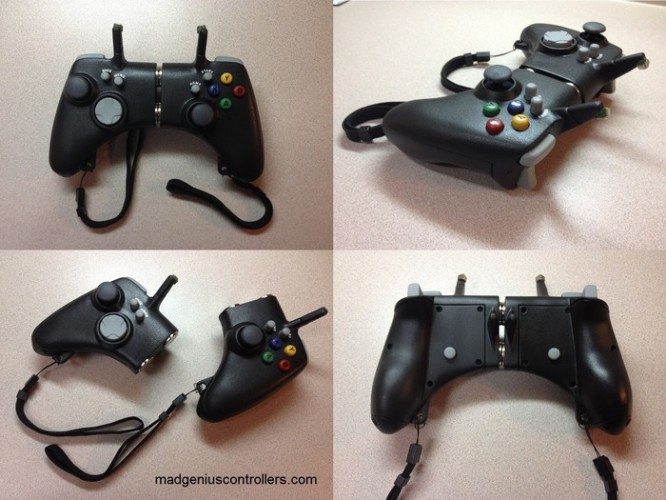Don Rider is the inventor of the Mad Genius motion controller which caught the attention of the VR community when prototypes of the system were first revealed. Rider has taken his creation to Kickstarter to refine and miniaturize the design for proper manufacturing. The VR community had plenty of questions about the system and we went directly to the source to get them answered.
The Mad Genius controller looks like a standard gaming controller but really consists of two halves connected by a powerful magnet. When split apart, the ultrasonic-based motion technology takes over, allowing players to control games using a combination of motion and gesture input. Rider says that the controller is accurate to 1/100th of an inch and also provides absolute positional tracking, rather than relative tracking that one would find with IMU-based systems.
He says that he’s applied for a patent for the technology.
“I don’t need any averaging of old samples. My “raw” (x,y,z) data is the data that I use—I don’t have to clean it up or include data from old samples. It took a lot of software to be able to get accurate data from a single sample. The methods used to do this take up quite a lot of the patent,” Rider told me.
He was clear that while the Mad Genius controller could be used for VR, that isn’t the intended use in the controller’s current form.
“At this point I want to produce optimized positioning solutions for other applications. I need that chip with all of the locating hardware to do this efficiently. VR is one of those applications but I haven’t optimized for it yet. One step at a time,” he said.
 But that hasn’t stopped the VR community from taking notice of what could be useful tech for consumer virtual reality. A thread posted on the Oculus sub-section of Reddit revealed many unanswered questions about how the system worked and what its limitations might be. A section of the Mad Genius website explains at length what the controller does, but not quite how it works.
But that hasn’t stopped the VR community from taking notice of what could be useful tech for consumer virtual reality. A thread posted on the Oculus sub-section of Reddit revealed many unanswered questions about how the system worked and what its limitations might be. A section of the Mad Genius website explains at length what the controller does, but not quite how it works.
Wanting to know more ourselves, we got in touch with Rider to see if he’d answer some questions for the community, he happily obliged. After calling for questions on Reddit, we passed them along to Rider who kindly answered them in great depth.
Community Q&A With Don Rider, Inventor of the Mad Genius Controller
Q: How are you planning on handling the Xbox wireless controller approval and licensing process, and does your budget account for the cost associated with it?
A: The connection between the Mad Genius controller and the Xbox (or any other console) isn’t a wireless connection so this isn’t an issue.
Here’s how it works. The controller halves (I suppose you can think of them as two controllers that can stick together) each have a transmitter that serves as the tracking marker. A sensor array of four sensors is attached to the outside frame of the flatscreen.
The sensor array determines the markers’ locations in absolute (x,y,z) space relative to the television. Velocity and acceleration is derived from the changing location data. All of this data is translated into standard console button and analog stick movements according to a Game Profile loaded for the game being played. These button and analog stick movements are merged with those from the physical buttons and analog sticks in the controller halves. The sum of the motion information and the button/stick information is sent to the console through a cable that plugs into the standard controller plug on the console.
This final link in the chain, sending the sum of the motion and button/sticks to the controller, can be changed to match the console. For a PS3 it sends PS3 controller commands. For an Xbox One it sends Xbox One commands. For older consoles (ie, the PS2) a different plug may be needed.
We still want the controller to be wireless. The wireless connection will be from the two controller halves to the sensor array. Since I control both ends of the wireless connection I can use any wireless connection I like.
Q: Do you intend to reduce the price for a consumer release? Would a $100 price tag be possible?
A: I don’t know if a $100 price tag is possible or not. Pulling accurate location data out of the ultrasound takes some custom components. I’m working from outside the console so I have to bring my own processors and do everything on board.
The cost is dependent on the quantity produced more than anything else. That’s what’s frustrating with getting started. If we’re producing quantities in the thousands we have to spread the fixed startup costs (FPGA development, setup for plastics, development, workspace and all that) over fewer units. When the quantities are low these costs wind up being more than the parts and materials going into the unit.
I want the Kickstarter price to be lower but at the quantities we’ll likely be producing the cost of each controller is high.
Post Kickstarter if the controller makes a splash we might end up making lots of them. If we’re making enough of them our costs go down and the price would go down as well. I don’t have a guess as to what this price might be at this point. We’re only on Step 2 and that’s Step 29.
This is always a sore point with Kickstarter backers and I understand and agree. Backers are the people who go the extra mile and lend their support when there’s risk. I sincerely appreciate their support. If I get to build this thing it will be because of their generous support.
In return for their trust and support they pay a higher price than people who wait and see. I don’t like this at all. I’m working on ways to even this up as best I can. I haven’t come up with anything I can do within the Kickstarter without violating the terms of service. I can’t offer any bonuses to backers in the future that might give them back some additional value. Everything is supposed to be delivered in one shot and then it’s over. I understand why they do this. If you have ongoing obligations and someone’s not happy what do you do?
I’m going to do something anyway, though. I have a few ideas and I’m open to any and all suggestions.
Q: You didn’t implement wireless support since CES 2014 (10 months ago), how can we be sure you’ll be able to do it in the next 11 months (ETA Nov 2015)?
A: The wireless connection will be between the controller and the sensor array. It’s a simple serial connection and there are a lot of drop-in solutions already available. Implementation is a matter of experimenting to see which one works the best and dropping the chip in. It’s not difficult and I’m not worried about whether it’s doable or not.
The problem with making the controller wireless at the current time has nothing to do with the difficulty (or lack thereof) of implementing the wireless connection.
I started this project in my garage. The prototype you see in the Skyrim and Halo videos was built by hand on a tiny budget with Radio Shack parts, duct tape and paper clips. One guy, zero funding. It was the result of a series of “Gee, I wonder if this will work?” questions. “I wonder if I can get accurate tracking?” so I built some hardware. “I wonder if I can get the tracking to work for a larger range?” so I built more. “I wonder if I can use this to make the game do something?” so more hardware. “I wonder if I can make it do something useful?” so more.
In order to add motion to a console game without an API there was a long list of problems to solve. I’d like to say I knew how to do everything up front, laid out a plan and executed an optimal design but few things work that way. I didn’t even know if it was possible. I tried a dozen things for every link in the chain until I found something that worked well.
At the garage stage it’s easier and cheaper to do this with full size parts. Making printed circuit boards gets expensive when designs are changing daily so everything is on through-hole cards. I wasn’t worried about being pretty and compact. I just wondered if I could make it work.
This is why the controller isn’t wireless. Using full size parts meant everything just won’t fit inside a controller shell. I put the controller circuitry on an outside card and ran a cable to the controller.
To make the controller wireless the full size parts have to go and everything needs to be done nice and clean with surface mount parts. I need to do more than just adding the wireless, I need to redesign the entire thing.
At this stage of the game I don’t have extra resources to burn. I’m not funded and there are so many other things to do. I’ve been evaluating manufacturing sources. CES brought me together with some parts manufacturers who had alternatives to what I used in the first prototype. These parts can bring down costs but I had to do a lot of building to see if they would do what I needed.
At the same time I’ve been tweaking the software inside the controller. Compare the tracking of Halo and Skyrim to the Titanfall video—I’ve made many improvements to the tracking and translation algorithms.
Those videos don’t make themselves!
It was a question of where to put my time. The wireless connection would be better but the system works the same whether the cable is there or not. When it comes to demonstrating the functionality (how it works and how well it works) the wireless connection doesn’t add very much to the demo compared to the effort required to redesign everything. There were other things that were much more important and that’s where I put my time.








